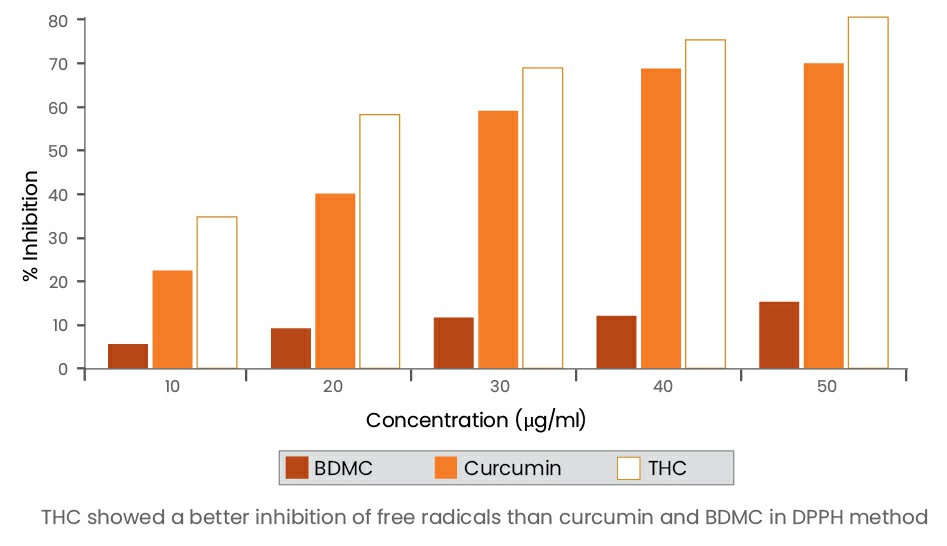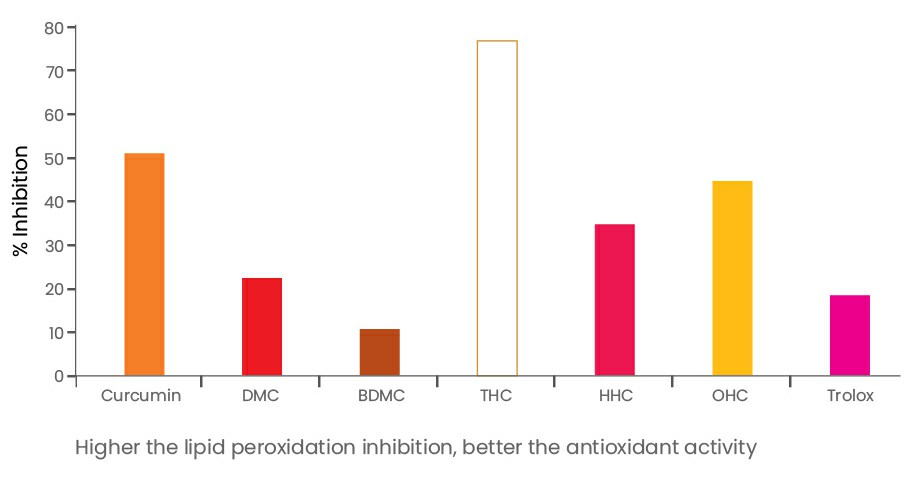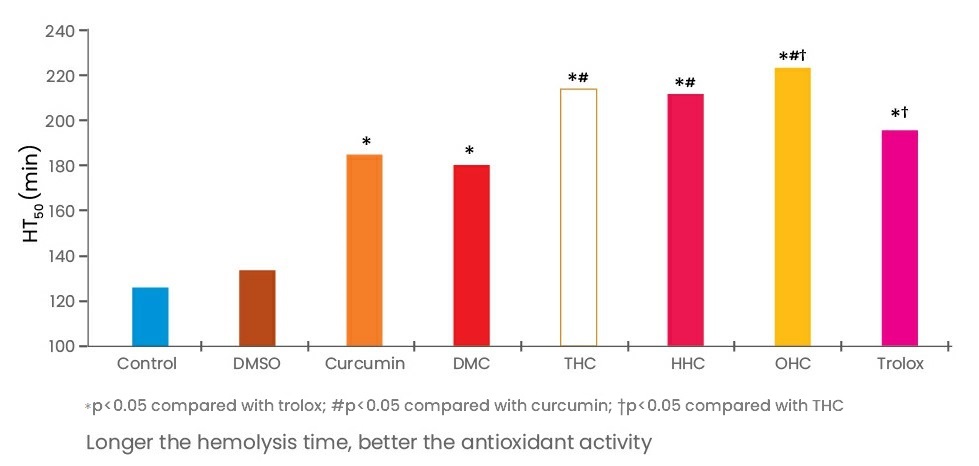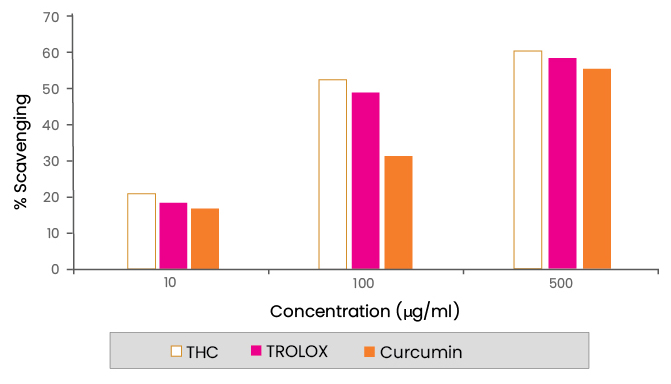Recently, attention has been focused on Tetrahydrocurcumin (THC) because this compound appears to exert a greater antioxidant activity than curcumin in both in vitro and in vivo systems (Okada et al., 2001; Majeed et al., 1995). Okada et al., (2001) have claimed that THC is more potent antioxidant than curcumin.
Superior DPPH radical scavenging ability by THC than curcumin and BDMC
In a series of studies conducted by Sabinsa Corporation, the free radical scavenging ability of curcumin, bisdemethoxycurcumin (BDMC) and THC were evaluated by using DPPH (2,2-diphenyl-1-picrylhydrazyl)-radical scavenging method.
The results shown in figure indicate that all test compounds resulted in significant neutralization of free radicals in a dose-dependent manner, with THC being the most effective followed by curcumin and BDMC.
Inhibition of AAPH-induced linoleic acid oxidation by curcumin and its derivatives
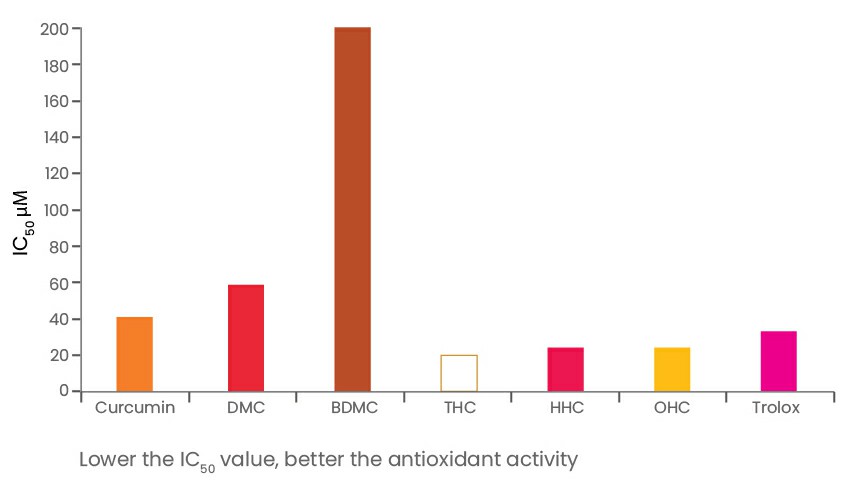
(Adapted from Majeed et al., 1995)
AAPH (2,2′-azobis(2-amidinopropane) dihydrochloride) is a water-soluble azo compound which is used extensively in the studies on lipid peroxidation as a free radical generator (Somparn et al., 2007).
A comparative study to identify antioxidant activity of curcumin, DMC, BDMC, and the hydrogenated derivatives (THC, HHC and OHC) was carried out using DPPH radical, AAPH-induced linoleic oxidation and AAPH-induced red blood cell hemolysis assays (Somparn et al., 2007). The DPPH scavenging activity was significantly higher in hydrogenated derivatives of curcumin than a reference antioxidant, trolox.
In the AAPH-induced linoleic oxidation model, it was found that hydrogenated derivatives of curcumin i.e., THC, Hexahydrocurcumin (HHC), Octahydrocurcumin (OHC) were stronger than the non hydrogenated curcuminoids – curcumin, DMC, BDMC (Somparn et al., 2007).
There was a significant decrease in hemolysis of red blood cells induced by AAPH in the order OHC > THC = HHC > TROLOX > Curcumin = DMC. The demethoxy derivatives of curcumin showed lower antioxidant activity in all experimental models, thus suggesting the involvement of the ortho-methoxyphenolic groups in antioxidant activity. On the other hand, hydrogenation at conjugated double bonds of the central seven carbon chain and β-diketone of curcumin to THC, HHC and OHC remarkably enhanced antioxidant activity (Somparn et al., 2007).
Studies have shown that the presence of phenolic hydroxyl groups and not the β-diketone moiety are responsible for the enhanced antioxidant activity of THC compared to curcumin (Portes et al., 2007).
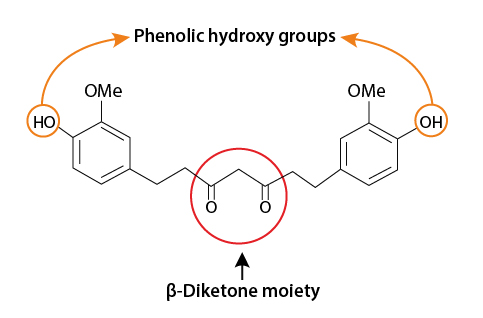
(Adapted from Majeed et al., 1995)
Tetrahydrocurcumin (THC): Effect on chloroquine (CQ)-mediated oxidative damage in rat kidney
The study was conducted to investigate effect of THC and curcumin against CQ-induced nephrotoxicity in female wistar rats. Female wistar rats treated with CQ were randomized administered with 80 mg/kg body weight of THC by oral route. The oral administration of THC alleviated the occurrence of CQ-induced renal damage, reduced the level of lipid peroxidation, and improved the status of non-enzymatic and enzymatic antioxidants in kidneys. Thus, the study concluded that THC has protective effect on CQ-induced and free radical-mediated oxidative renal impairment in rats. It was inferred that the antioxidant activity of THC might be responsible for the observed protection against CQ-induced peroxidative damage. The study results suggest that THC found to be helpful in the protection of CQ-induced oxidative damage in renal tissue (Pari and Murugan, 2006).
Scavenging potential of reactive oxygen species by THC
The main objective of this study was to investigate the antioxidant properties of THC. Healthy wistar albino rats, aged 8–10 weeks old and weighing about 150–180 g, were used for experiments. The scavenging response of THC was evaluated by using a series of in vitro models of chemicals in comparison with standard antioxidant viz., trolox and curcumin. The radical scavenging effect of THC was manifested in concentration-dependent manner on superoxide, hydroxyl radicals, ferric ions, DPPH (1,1-diphenyl, 2-picryl hydrazyl) and ABTS (2,2-azinobis-(3-ethylbenzothiazoline-6-sulphonate)). Further, the inhibitory response of THC on membrane lipid peroxidation by thiobarbituric acid reactive substances (TBARS) was evaluated using rat liver homogenate.
Together these results suggest that THC is a good antioxidant compared to the standard antioxidant, trolox, and concludes that THC with its improved stability is effective in preventing membrane lipid peroxidation induced by FeSO4/ascorbate in a concentration-dependent manner. Further, THC increased the superoxide scavenging ability and decreased ability to reduce ferric ions (Prabhu et al., 2011).
Antioxidant effect of THC in streptozotocin (STZ)–nicotinamide-induced diabetic rats
The study investigated the effect of THC on tissue lipid peroxides and antioxidants in rats with STZ- and nicotinamide-induced diabetes. Adult male albino wistar rats administered with THC (80 mg/kg body weight) for 45 days showed reduction in blood glucose level, increased in plasma insulin levels, improvement in activities of superoxide dismutase, catalase, glutathione peroxidase, glutathione-S-transferase, reduced glutathione, vitamin C and vitamin E in liver and kidney of diabetic rats with significant decrease in TBARS and hydroperoxides formation in liver and kidney. These results suggest that THC exhibits significant antihyperglycemic activity by protecting the tissues against STZ action, and the protective effect of THC is more prominent compared to curcumin (Murugan and Pari, 2006).
Comparative and combined effect of chlorogenic (CGA) acid and THC on antioxidant disparities in chemical-induced experimental diabetes
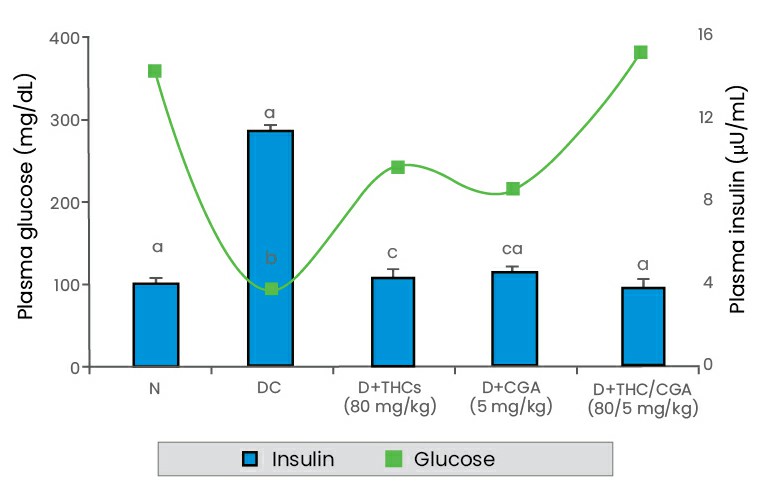
N -Normal, D – Diabetic, DC – Diabetic control and
CGA – Chlorogenic acid
The purpose of this study was to evaluate the combined effect of THC and CGA on oxidative stress in STZ–nicotinamide-induced diabetic rats. Six-week-old male albino wistar rats were rendered diabetic by single intraperitoneal (i.p) injection of STZ (45 mg/kg body weight), 15 min after an i.p injection of nicotinamide (110 mg/kg body weight). Then the following factors were evaluated: fasting plasma glucose, insulin, oxidative stress, levels of enzymatic antioxidants and lipid peroxidation.
The diabetic rats had increased the levels of fasting plasma glucose, lipid peroxidative products, and decreased the levels of plasma insulin and enzymatic antioxidants. Chlorogenic acid (5 mg/kg body weight) and THC (80 mg/kg body weight) were orally administrated to diabetic rats by intragastric intubation for 45 days, thus reversed the biochemical changes to near normal.
The present study concludes that combined effect of THC and chlorogenic acid improved enzymatic antioxidants with a concomitant decrease in lipid peroxidation and protected against STZ–nicotinamide-induced type-2 diabetes in experimental rats (Pari et al., 2010).

